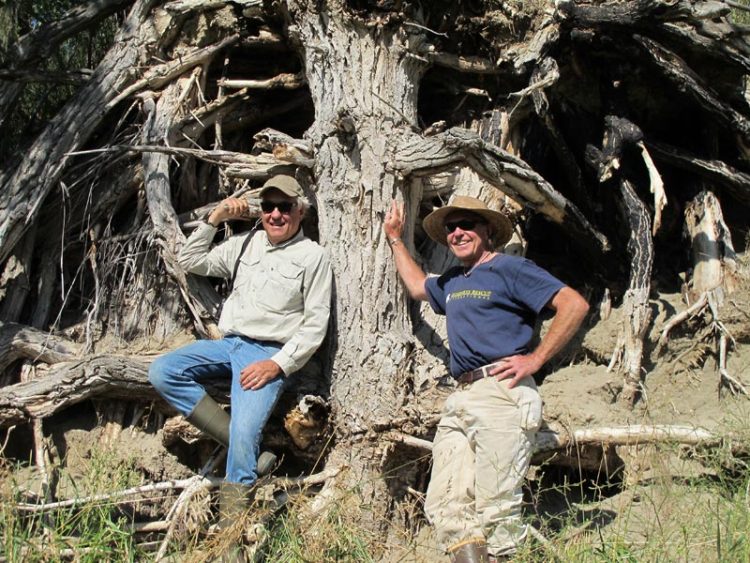Ecologist Stresses Importance of Wetlands, Grasslands in Midwest

South Dakota State University Distinguished Professor W. Carter Johnson and Michael Scott, a research ecologist from the U.S. Geological Survey in Ft. Collins, Colorado, examine the intriguing cottonwood root system to evaluate the effect of 2011 Missouri River flooding.
Wetlands may be the least understood ecosystem, but their value is immense, according to Distinguished Professor W. Carter Johnson of the South Dakota State University Department of Natural Resource Management. “Anything that affects them will have a big impact on the landscape.”
For more than 40 years, the ecologist has studied wetlands along rivers and in the prairie pothole region that extends from Canada through the Dakotas to Iowa. In recognition of his contributions to wetlands conservation, Johnson received the National Wetlands Award for Science Research from the Environmental Law Institute.
Since 1989, the National Wetlands Awards program has honored individuals who have demonstrated extraordinary commitment to our nation’s wetlands.
Understanding importance of wetlands
Through his wetlands research, Johnson has sought to help people understand their importance. “They have so much biodiversity and importance to the health of the landscape,” he noted, citing wetlands teaming with birds, amphibians and beneficial insects. In addition, wetlands retain floodwaters and filter water naturally.
South Dakota has a unique legacy in its mixture of lakes, wetlands and grasslands. ”It’s an incredibly beautiful and productive landscape and we haven’t treated it very well,” Johnson said.
Most of the river or riparian wetlands along the Missouri River were lost when the reservoirs were established, according to Johnson. He estimated that 80 percent of the riparian wetlands have been destroyed. The only sizable remnants in South Dakota occur below Gavins Point and Fort Randall Dams. These reaches “retain much of their original biodiversity observed by Lewis and Clark,” he explained.
For his dissertation in the early 70s he studied the forests along the river. Two years ago, he looked at what has changed over the last 40 years. “The cottonwood is on the way out,” he noted, because they “require floods and new sandbars to regenerate.” American elm is mostly gone from Dutch elm disease and ash trees are being threatened by the emerald ash borer.
Restoring tall prairie grasses
Seven years ago, Johnson became one of the founders of the EcoSun Prairie Farms to demonstrate the viability of a “working grass farm,” as a means of restoring tall grass prairie and pothole wetlands. He and his cohorts formed the nonprofit organization and leased a section of land near Colman, where they began planting blue stem, prairie cord grass and other perennial species native to the area on retired cropland.
The farm generates income from three main sources—forage hay, native plant seed and, more recently, grass-fed beef, he explained. The native grasses require less input than rowcrops, while resulting in less erosion, better soil and water quality and more wildlife.
During the dry summer of 2012, he pointed out, “the grass farm didn’t show drought.” The plants were a bit shorter, but “nothing died and it all came back the next year.” A recent analysis showed a net yearly farm profit of $60,000, and the highest income levels came from wetland acres.
“It’s a different way of farming,” Johnson admitted, but one that farmers who own 400 to 600 acres might want to consider. “I hope we can get it worked onto other farms.”
About South Dakota State University
Founded in 1881, South Dakota State University is the state’s Morrill Act land-grant institution as well as its largest, most comprehensive school of higher education. SDSU confers degrees from eight different colleges representing more than 175 majors, minors and specializations. The institution also offers 29 master’s degree programs, 13 Ph.D. and two professional programs.
The work of the university is carried out on a residential campus in Brookings, at sites in Sioux Falls, Pierre and Rapid City, and through Cooperative Extension offices and Agricultural Experiment Station research sites across the state.
Contact Information
Christie Delfanian
Research Writer
christie.delfanian@sdstate.edu
Phone: 605-688-4541
Mobile: 605-651-4183
carter.johnson@sdstate.edu
605-688-4729
Media Contact
More Information:
http://www.sdstate.eduAll latest news from the category: Ecology, The Environment and Conservation
This complex theme deals primarily with interactions between organisms and the environmental factors that impact them, but to a greater extent between individual inanimate environmental factors.
innovations-report offers informative reports and articles on topics such as climate protection, landscape conservation, ecological systems, wildlife and nature parks and ecosystem efficiency and balance.
Newest articles

First-of-its-kind study uses remote sensing to monitor plastic debris in rivers and lakes
Remote sensing creates a cost-effective solution to monitoring plastic pollution. A first-of-its-kind study from researchers at the University of Minnesota Twin Cities shows how remote sensing can help monitor and…

Laser-based artificial neuron mimics nerve cell functions at lightning speed
With a processing speed a billion times faster than nature, chip-based laser neuron could help advance AI tasks such as pattern recognition and sequence prediction. Researchers have developed a laser-based…

Optimising the processing of plastic waste
Just one look in the yellow bin reveals a colourful jumble of different types of plastic. However, the purer and more uniform plastic waste is, the easier it is to…



